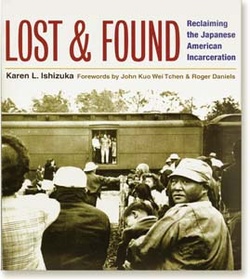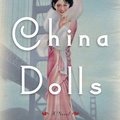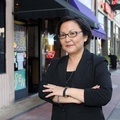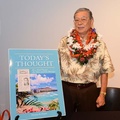In addition to her credits as an award-winning producer and writer, Karen L. Ishizuka is respected for her work as the curator of the Japanese American National Museum’s critically acclaimed 1994 exhibition, America’s Concentration Camps: Remembering the Japanese American Experience.
In an interview with the Japanese American National Museum for this article, Ishizuka recalled her work with the National Museum. “When I was asked to curate America’s Concentration Camps, I had already done a lot of work on the camps, and I thought I knew a lot. Yet despite all my past years of research and writing about the camps, I was still overwhelmed by the depth of strength, determination and pain of the 120,313 people whose direct experience it was. Each person who went through camp is a story worth telling and learning from. I was constantly amazed and humbled by the stories that I was privy to hear. And there are so many stories that have yet to be told and may never be told.”
One of the most memorable qualities of America’s Concentration Camps was the participatory or interactive nature of the exhibition. This element, it seems, is what creators and visitors alike remembered most. According to the author: “My goal for the exhibition was to create an experiential environment in which former inmates could revisit their camp experience not as victims or passive viewers but as dynamic makers and tellers of history. Although my mandate as curator was to create an introductory exhibition to the camps, my responsibility as a Sansei was to make it meaningful to those who went through the camps.”
Ishizuka has now published a book about the exhibition entitled Lost & Found: Reclaiming the Japanese American Incarceration. Her book, however, does much more than document the life of the exhibition. As Ishizuka narrates the history of America’s Concentration Camps, from its conception to its opening, readers may feel that the author actually recreates the exhibition and allows it to emerge in a different form. Lost & Found, like the exhibition on which it is based, moves, influences, and communicates with readers, bringing the experience of America’s Concentration Camps to life all over again.
As with every project she has undertaken, Ishizuka worked to achieve specific goals when writing Lost & Found. “My goals for the book are: to convey this critical process of personal and community reclamation, to firmly place the inmates’ direct experiences into the canon of American history, and to reinforce the notion that none of us are passive viewers in life, but that each of us have the opportunity, right, and responsibility to make and affect history every day.” The author adds, “I wanted to make transparent the process by which exhibitions are created, especially the dialogic strategy and design that involves the community in the telling of its own history. During the exhibition there were so many unexpected and enlightening stories that would go unknown if they weren’t written down so others might be enriched as I was. I was so taken with these stories I wanted to share them with others. And there were so many discoveries and lessons that continued after the exhibition—such as the intense national dialogue that went on between and within Japanese American and American Jewish communities about the meaning of the term ‘concentration camp’—that would be lost if not written down. The exhibition was like a stone thrown into a pond which created ripples that were as informative, interesting, and evocative as the exhibition itself—but that only I could see. The book is about making visible those ripples.”
The exhibition obviously had a powerful effect on everyone involved. Through Lost & Found, Karen Ishizuka hopes that the stories within the exhibition will continue to be told and heard. “An exhibition, no matter how effective, is ephemeral. Once dismantled, it exists only in the memories of those who went to it; it’s effectiveness limited to those who had the time, initiative and indeed money to actually go to the museum or venue. Books are tangible. They have no closing date. They can be passed on, checked out, re-read, marked-up. In this way I believe books have a greater capacity to strategically affect and enlarge what is considered the canon of American history and culture. If we don’t insert our history into that canon, we are in danger of it being lost or interpreted for us. Jack Tchen wrote in the foreword, ‘Let America be America again. The land that never has been yet, and yet must be.’ I hope Lost & Found helps our voices to be heard so that America can be the America it must be.”
The exhibition America’s Concentration Camp: Remembering the Japanese American Experience was at the Japanese American National Museum from November 11, 1994–October 15, 1995. It later traveled to New York’s Ellis Island (1998), Atlanta (1999), and San Francisco (2000), before ending its journey in Little Rock, Arkansas (2004).
* This article was originally published on the Japanese American National Museum Store Online.
© 2007 Japanese American National Museum







